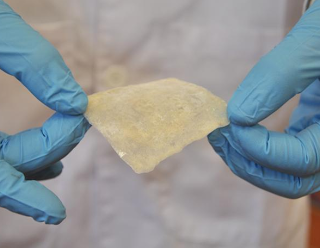The new membrane promises greater cost-effectiveness in delivering energy, but also an environmentally-friendly solution. The researchers used a polystyrene-based polymer to deposit the soft, foldable membrane that, when sandwiched between and charged by two metal plates, could store charge at 0.2 farads per square centimeter. This is well above the typical upper limit of 1 microfarad per square centimetre for a standard capacitor.
The cost involved in energy storage is also drastically reduced. With existing technologies based on liquid electrolytes, it costs about US$7 to store each farad. With the advanced energy storage membrane, the cost to store each farad falls to an impressive US$0.62. This translates to an energy cost of 10-20 watt-hour per US dollar for the membrane, as compared to just 2.5 watt-hour per US dollar for lithium ion batteries.
energy storage membrane
Polymer Physics – Supercapacitive energy storage based on ion-conducting channels in hydrophilized organic network
Conventional electrode materials for supercapacitors are based on nanoscaled structures with large surface areas or porosities. This work presents a new electrode material, the so-called hydrophilized polymer network. The network has two unique features: 1) it allows for high capacitance (up to 400 F/g) energy storage in a simple film configuration without the need of high-surface-area nanostructures; 2) it is unstable in water, but becomes extremely stable in electrolyte with high ionic strength. The above features are related to the hydrophilizing groups in the network which not only generate hydrated ionic conduction channels, but also enable the cross-linking of the network in electrolyte. Because of its practical advantages such as easy preparation and intrinsic stability in electrolyte, the hydrophilized network may provide a new route to high-performance supercapacitive energy storage. © 2011 Wiley Periodicals, Inc. J Polym Sci Part B: Polym Phys 49: 1234–1240, 2011
The performance of the membrane surpasses those of rechargeable batteries, such as lithium ion and lead-acid batteries, and supercapacitors.
Potential applications: From hybrid vehicles to solar panels and wind turbines
The membrane could be used in hybrid vehicles for instant power storage and delivery, thus improving energy efficiency and reducing carbon emission. Potentially, hybrid cars with the membrane technology could be powered by the energy stored in the membranes in conjunction with the energy provided by fuel combustion, increasing the lifespan of car batteries and cutting down on waste.
The membrane could also be integrated into solar panels and wind turbines to store and manage the electricity generated. Energy provided through these sources is prone to instability due to their dependence on natural factors. By augmenting these energy sources with the membrane, the issue of instability could potentially be negated, as surplus energy generated can be instantly stored in the membranes, and delivered for use at a stable rate at times when natural factors are insufficient, such as a lack of solar power during night-time.
Next Step
The research team has demonstrated the membrane’s superior performance in energy storage using prototype devices. The team is currently exploring opportunities to work with venture capitalists to commercialise the membrane. To date, several venture capitalists have expressed strong interest in the technology.
“With the advent of our novel membrane, energy storage technology will be more accessible, affordable, and producible on a large scale. It is also environmentally-friendly and could change the current status of energy technology,” Dr Xie said.
1 page of supporting information in a word doc
If you liked this article, please give it a quick review on ycombinator or StumbleUpon. Thanks

Brian Wang is a Futurist Thought Leader and a popular Science blogger with 1 million readers per month. His blog Nextbigfuture.com is ranked #1 Science News Blog. It covers many disruptive technology and trends including Space, Robotics, Artificial Intelligence, Medicine, Anti-aging Biotechnology, and Nanotechnology.
Known for identifying cutting edge technologies, he is currently a Co-Founder of a startup and fundraiser for high potential early-stage companies. He is the Head of Research for Allocations for deep technology investments and an Angel Investor at Space Angels.
A frequent speaker at corporations, he has been a TEDx speaker, a Singularity University speaker and guest at numerous interviews for radio and podcasts. He is open to public speaking and advising engagements.


